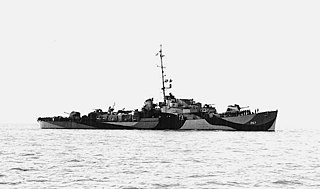Related Research Articles

USS Dufilho (DE-423), was a John C. Butler-class destroyer escort.

USS George (DE-697) was a Buckley-class destroyer escort. She was the second ship of the United States Navy named after Seaman Second Class Eugene F. George (1925–1942), who was posthumously awarded the Navy Cross for his heroism on USS San Francisco at the Naval Battle of Guadalcanal.

USS Cook (APD-130) was a Crosley-class high speed transport of the United States Navy, named after two brothers: Second Lieutenant Andrew F. Cook, Jr. (1920–1942) and Sergeant Dallas H. Cook (1921–1942). Both served in the Marine Corps, and both were awarded the Navy Cross, posthumously.

USS Crouter (DE-11) was an Evarts-class destroyer escort of the United States Navy in commission from 1943 to 1945. The ship was named after Mark Hanna Crouter (1897–1942), U.S. Navy officer and Navy Cross recipient.

USS Mitchell (DE-43) was an Evarts-class destroyer escort constructed for the United States Navy during World War II. She was sent off into the Pacific Ocean to protect convoys and other ships from Japanese submarines and fighter aircraft. She performed escort and anti-submarine operations in dangerous battle areas and was awarded nine battle stars, a very high number for a ship of her type.

USS Crowley (DE-303) was an Evarts-class destroyer escort of the United States Navy during World War II. She was sent off into the Pacific Ocean to protect convoys and other ships from Japanese submarines and fighter aircraft. She performed escort and antisubmarine operations in dangerous battle areas and returned home with five battle stars.

USS Cooner (DE-172) was a Cannon-class destroyer escort in service with the United States Navy from 1943 to 1946. She was sold for scrap in 1973.

USS Jesse Rutherford (DE-347) was a John C. Butler-class destroyer escort acquired by the United States Navy during World War II and named in honor of Private Jesse Rutherford Jr., USMC. Her primary purpose was to escort and protect ships in convoys; other tasks assigned included patrol and radar picket. Post-war, she returned home with one battle star to her credit.

USS French (DE-367) was a John C. Butler-class destroyer escort in service with the United States Navy from 1944 to 1946. She was scrapped in 1973. The ship was named in honor of Neldon Theo French who was awarded the Navy Cross for his actions during the Guadalcanal Campaign.

USS Leland E. Thomas (DE-420) was a John C. Butler-class destroyer escort in service with the United States Navy from 1944 to 1946. She was scrapped in 1973.
USS ATA-176 was an ATR-1-class rescue tug built for the United States Navy during World War II. She was laid down on 30 January 1944 and launched on 1 March as USS ATR-103, but was re-designated ATA-176 on 15 May. She was commissioned as USS ATA-176 on 19 August. She served in the U.S. Pacific Fleet during the war and was decommissioned on 30 June 1947. She was then manned with a civilian crew and placed in service, being renamed USNS Tonkawa (T-ATA-176) on 16 July 1948. Tonkawa, the first U.S. Navy vessel named for the Tonkawa, was taken out of service in 1956 and placed in reserve.

USS Grimes (APA-172) was a Haskell-class attack transport in service with the United States Navy from 1944 to 1947. She was scrapped in 1974.

USS Horace A. Bass (DE-691/APD-124/LPR-124) was a United States Navy high-speed transport in commission from 1944 to 1969.

USS Kinzer (APD-91), ex-DE-232, was a United States Navy high-speed transport in commission from 1944 to 1946.

USS Knudson (APD-101), ex-DE-591, later LPR-101, was a United States Navy high-speed transport in commission from 1944 to 1946 and from 1953 to 1958.

USS Rednour (APD-102) was a Crosley-class high speed transport that served in the United States Navy from 1945 to 1946. In December 1969, she was transferred to Mexico and served as Chihuahua until July 2001.

USS Kline (APD-120) was a Crosley-class high-speed transport in commission with the United States Navy from 1944 to 1947. She was transferred to the Republic of China Navy in 1966 and served as ROCS Shou Shan (PF-37/PF-893/PF-837) until 1997. She was finally sunk as a target in 2000.

USS Pavlic (APD-70) was built by Dravo Corporation at Pittsburgh, Pennsylvania as a Buckley-class destroyer escort. Pavlic was launched 18 December 1943 and towed to Texas for refitting as a United States Navy high-speed transport. Pavlic was in commission from 1944 to 1946, serving in the Okinawa campaign as a radar picket ship. Pavlic was decommissioned 15 November 1946. After more than 20 years of inactivity in reserve, she was stricken from the Navy List on 1 April 1967. On 1 July 1968, she was sold for scrapping to North American Smelting Company.

USS Yokes (APD-69), ex-DE-668, was a United States Navy high-speed transport in commission from 1944 to 1946.
References
- 1 2 3 4 Staff, "Queens Writer Killed When Plane Explodes", Long Island Star-Journal, Long Island City, New York, Thursday August 2, 1945, page 11.
- 1 2 3 4 "Newspaper article" (PDF). fultonhistory.com. August 2, 1945.
- ↑ Raudy, John Hill, "The Price of News: American War Correspondent Casualties - A Thesis in Mass Communications", Texas Tech University, Lubbock, Texas, August 1977, pages 120-121.
- ↑ file:///C:/Documents%20and%20Settings/Owner/My%20Documents/Downloads/31295001201630.pdf
- ↑ United Press, "I.N.S. Correspondent Killed in Plane Crash", The San Bernardino Daily Sun, San Bernardino, California, Thursday August 2, 1945, Volume 51, page 2.
- ↑ Moseley, Ray (July 9, 2018). Reporting War: How Foreign Correspondents Risked Capture, Torture, and Death to Cover World War II. Yale University Press. ISBN 9780300224665 – via Google Books.
- 1 2 Staff correspondent, "Newsman Dies In Bomber Crash", The Sydney Morning Herald, Sydney, Australia, Friday August 4, 1945, 115th Year, Number 33,576, page 1.
- ↑ "The Sydney Morning Herald (NSW : 1842 - 1954) - 3 Aug 1945 - p1". Trove.
- ↑ "UPI journalists listed at monument - UPI Archives". UPI.com.